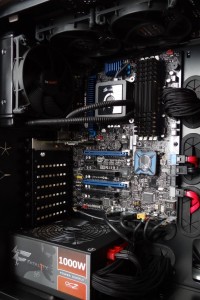BENCHMARK PROTOCOL AND THE TEST BENCH
 This is our new Intel Z77 Test Bench. A quick click on the photo will give you a better look.
This is our new Intel Z77 Test Bench. A quick click on the photo will give you a better look.
In testing, our main objective is to obtain results as pure and as accurate as possible and we want to ensure that no anomalies slip through. Simply put, we want to provide you with the absolute best results the tested hardware can provide. Repetition in testing is standard and, if necessary, we may conduct specific tests in Windows 7 safe mode to ensure the OS has little to no influence on the end result.
In order to validate and confirm our findings, testing is supported by industry accepted benchmark programs. All results are displayed through capture of the actual benchmark for better understanding of the testing process by the reader.
We would like to thank Intel, Corsair, Patriot, OCZ, and Be Quiet, for sponsoring components of our Test Bench.
SSD COMPRESSION AND TESTING FLUCTUATIONS
All SSDs are not created equal and many new SSD enthusiasts realize that when they test their new drive to confirm specifications and ensure all is in order. LSI SandForce controlled SSDs, as in the Comay Venus Pro 3 240GB SSD we are testing today, use compression techniques in storage whereas many others do not.
 This creates a bit of confusion when enthusiasts test the drive with random data through benchmarking programs such as AS SSD and Crystal DiskMark. The results seem to be lower than the listed specifications.
This creates a bit of confusion when enthusiasts test the drive with random data through benchmarking programs such as AS SSD and Crystal DiskMark. The results seem to be lower than the listed specifications.
BENCHMARK SOFTWARE
The software we will be using for todays analysis is typical of many of our reviews and consist of ATTO Disk Benchmark, Crystal DiskMark, AS SSD, Anvil Storage Utilities, HDTune Pro, and PCMark Vantage. We rely on these as they each have a way of supporting one another yet, at the same time, adding a new performance benchmark to the total picture. Much of the software is free and can be downloaded simply by clicking on the linked title.
CRYSTAL DISK INFO VER 3.9.3
Crystal Disk Info provides some excellent information about the SSD itself to include its health, operating temperature, product information, power on information as well as the characteristics of the SSD. Full credit has to go to Comay for such an in depth look inside the Venus Pro 3.
 The SSD Review The Worlds Dedicated SSD Education and Review Resource |
The SSD Review The Worlds Dedicated SSD Education and Review Resource | 
tbh i was hoping this new pro version SSD would do extremely well, was really looking foward to a sandforce drive out perform the plextor m3pro. currently sandforce drives been doing pretty well with the incompressible data at over 300mb/s but thats just crystaldisk though, which shows the best possible results unlike AS SSD which shows the worst possible result.
quite frankly the lowest results showing in AS SSD for plextorm3p are way too good, and its access time simply amazing lol. sandforced write latency usually around .18-.2 ms, just cant beat marvel/samsung controller.
i’ll probably just wait till something* that has really good 4k speed, something a bit better than the intel 520 drives
you can buy this product with contact iPCZEN.
http://www.ipczeninformatique.fr
I’ve always wondered just how much a supercap adds to the price of an SSD. I suspect very little. These should have been standard on all models, not just the enterprise ones. Just a marketing gimmick to boost prices.
As for access time performance you have to be cautious here. A controller designer can use DRAM as a crutch to boost performance and there is always a tradeoff. In this case it’s an incrfeased risk of data corruption or loss. The large DRAM cache becomes a data integrity risk as well as performance enhancer. Hell, if you used enough DRAM you could achieve RAMDISK performance across the board.
The supercap adds a few $s to the BOM, depending on the size of the cache, and whether the device/controller operates in cache protection mode (which keeps some flash memory erased and ready to accept the contents of the cache).
As for their use of DRAM cache to speed up performance, that’s why CoreRise has used the supercap: You get all the write speed benefits of a large DRAM cache, with no loss of data integrity. The supercap acts as an internal UPS to ensure that there’s time to write all the cache contents to flash after a power loss/interruption.